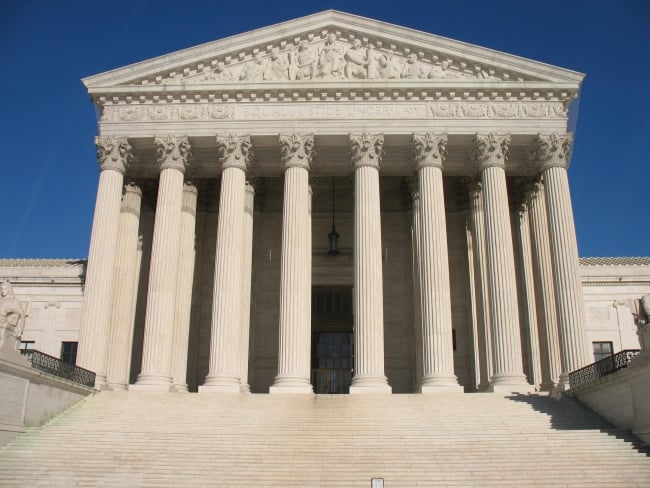You have /5 articles left.
Sign up for a free account or log in.

Kjetil Ree, CC BY-SA 3.0, via Wikimedia Commons
Although the Supreme Court’s decision in Students for Fair Admissions v. Harvard came as no surprise, its mandate to exclude the consideration of race in college admissions feels like a gut punch, especially to those of us who have been longtime advocates for educational equity. Even more upsetting is that the court justified its decision under the equal protection clause, initially enacted to protect the rights of African Americans, which this court will likely use in future opinions in ways that destabilize advances made by people of color.
Despite the obvious setback that this decision represents, it also presents an opportunity for universities to adopt a modern, equitable and inclusive approach to college admissions. Although conventional metrics provide limited quantifiable data about an applicant’s likely academic performance, the Supreme Court’s ruling warrants highlighting several limitations to these metrics that universities should consider in forging a new path without affirmative action.
The Merit Myth
While merit-based admissions have long been considered a fair and efficient way to select students, in its effort to “eliminate all” racial discrimination, the Supreme Court fails to acknowledge that the American educational system is overwhelmingly racist and classist. K-12 educational deficits, which exist generally in historically underserved communities, inevitably have an impact on Black and Latino students’ access to higher education. Black and Latino students are:
- More likely to be taught by inexperienced teachers;
- More likely to attend schools where most of their peers come from low-income families;
- More likely to attend the lowest-funded schools;
- Less likely to have educational resources such as learning disability support, small class sizes and tutoring; and
- Less likely to have access to Advanced Placement (college-level) courses and extracurricular activities that develop skills that prepare students for higher education.
These, and other educational inequities, disparately impact Black and Latino student learning in ways that inevitably skew college admissions decisions that significantly rely on conventional merit-based metrics. “Merit,” as conventionally defined, rests heavily on the metrics of standardized test scores, GPAs and class rankings. A deeper understanding of educational and social inequity reveals that such merit is largely determined by the cumulative advantages an individual possesses and, therefore, favors those who have had more opportunities and advantages, largely due to race and/or socioeconomic background. Hence, predominant use of conventional merit-based metrics perpetuates systemic racism, classism, exclusion and marginalization.
It is also important to acknowledge the limitations of conventional merit metrics that may not adequately represent the full range of student ability, potential and experiences. For example, aptitude to overcome obstacles and problem-solving are skills just as necessary for college and life success as any other predictor. Additionally, students with unique talents, such as artistic ability, may be overlooked or undervalued in conventional merit-based evaluations.
Varsity Blues
Higher education admissions practices at prestigious universities have overwhelmingly preserved racism and classism, even before the Supreme Court’s ruling. The 2019 Varsity Blues scandal should have been the wake-up call, making clear that higher education admissions decisions are not exclusively based on the criteria of conventional merit. The scandal revealed wealthy parents bribing college officials, faking test scores and otherwise manipulating the admissions process to secure spots at prestigious universities for their children.
The scandal shed light on how privilege favors the affluent and can distort the admissions process, despite the reliance on so-called merit-based practices. The scrutiny brought about by the scandal stopped short of examining whether the notion of merit itself is inherently flawed. In the wake of the scandal, we missed the opportunity to examine higher education’s problematic obsession with narrow metrics.
One of the challenges of a merit-based system—unaffected by scandal—is how it perpetuates inhibited access to higher education for the underserved while sustaining alignment with wealth. Derrick Bell, godfather of critical race theory and reluctant supporter of affirmative action, noted that one of the fallacies of affirmative action was that conventional admissions standards remained oriented to benefit upper-middle-class, predominantly white individuals.
Bell predicted that affirmative action would increase the “real and continuing hostility between poor whites and their Black and [Latino] counterparts,” which it has, and supported minority admission programs only because little else was available. According to Bell’s interest convergence theory, the opportunities for Black and Latino students will only dramatically improve when the interests of students of color also advance the interests of elite whites. If this is true, the academic and private business communities should be collaborating in ways that demonstrate to universities the consequences of failing to enroll a diverse student body and to educate students on the cultural competence required to be most productive. This likely also requires a re-examination of merit.
Measuring Merit
Acknowledging that conventional merit-based evaluative criteria are inherently exclusive and based on historical racism and classism requires universities to redefine the concept of merit. In addition to the Supreme Court’s mandate to exclude race from admissions consideration, admission practices that overvalue metrics that were developed on the premise of historical exclusion of students of color should be abandoned as well.
Merit should not be assessed wholly on a candidate’s current achievements, but rather, should be viewed in the context of an individual’s circumstances and in relation to their starting point and the obstacles they have overcome—thus “merit” should also take into consideration grit, determination and potential. By understanding the unique circumstances of each applicant, we can assess student achievements within a broader context that provides more insight into the candidate.
Last week President Biden proposed a similar standard, encouraging colleges “to take into account the adversity a student has overcome when selecting among qualified applicants,” and the medical school at the University of California, Davis, reportedly rates each applicant on an “adversity score” that takes into account factors including family income and parental education levels. Admissions and inclusion offices that adopt such approaches should further be afforded resources to cultivate environments that help sustain them, so that underrepresented students can succeed and thrive.
This more inclusive and fair assessment of merit would help mitigate the impact of systemic disadvantage and is in no form “racial balancing” as declared “patently unconstitutional” by the court. This evaluation of merit would conceivably be supported by the Supreme Court, given Chief Justice John Roberts’s specific mention that nothing in the opinion “should be construed as prohibiting universities from considering an applicant’s discussion of how race affected his or her life, be it through discrimination, inspiration or otherwise.”
A new, more inclusive definition of merit provides higher education with an opportunity to reinvent itself. By identifying candidates that will represent and produce many different versions of “success,” under a modern and more inclusive assessment of merit, higher education can evolve in ways that alleviate the harm of the court’s affirmative action jurisprudence.




